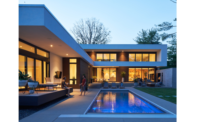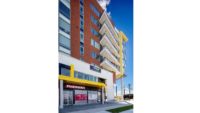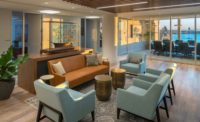Originally established in 1980, Architectural Resource Corporation’s founders earned an enduring reputation for superior client service and design. Current owner and lead architect Ari Berdusis purchased the Frankfort-based business 12 years ago and has continued the tradition of striving for quality assurance and excellence. With close to 80% of its business designated as municipal, the firm is known for pursuing the next level of design and construction to better serve its communities. Berdusis combines critical thinking and attention to detail to drive the success of all projects, including his recent dazzling field house additions to four Southwest Chicago high schools that comprise Bremen High School District 228.
The district has undergone vast expansion since the original Bremen High School opened its doors to students in September of 1953. To keep up with the area’s subsequent increase in population, three additional high schools were constructed—Tinley Park in 1961, Hillcrest in 1967 and Oak Forest in 1970—creating a four high school district, which now serves over 5,000 students and employs 613 full and part-time staff members.
Funding from the Federal Qualified School Construction Bond (QSCB) Program created an opportunity for the district to provide updates, renovations and improvements to each of its high schools, with similar amenities and benefits for each. The program expanded indoor space by 50,000 square feet, with each school getting a new fieldhouse, new fitness center and various classroom expansions.
District Superintendent, Dr. Bill Kendall commented, “With these new field houses, we can host indoor meets, have additional space for physical education classes and expand health and wellness opportunities for our students.”
While the ARC team took on the task of creating a discrete modern masonry design for each of the new structures, they partnered with colleagues from sister company, Concept Development Group, who oversaw construction. In addition, the skills of veteran masonry firm, J & E Duff, Inc., were enlisted to install the intricate configurations. The individual designs, as well as the wide scope of the project, created a need for several different colors and textures, which were all supplied by Echelon/Northfield Masonry, manufacturers of Trenwyth architectural CMUs.
Although the creation of complementary additions to each of these veteran structures presented a series of hurdles for the various contractors, the assorted professionals negotiated each one with unflappable determination coupled with trademark Midwestern fortitude.
Berdusis explained, “We faced multiple challenges at each site including grading, soil conditions, wetland preservation, parking requirements, lighting and screening. These pre-existing conditions were a factor in the orientation and placement of the additions.”
ARC project manager, Karen Slattery added, “These older buildings had two or three additions with different colored brick, which created an aesthetic design challenge from the start—how to integrate existing features with new and provide cost efficient, low maintenance buildings.”
Burdusis’s design took all these factors into consideration. “We needed to bring the scale of the fieldhouse down to meet the scale of the existing buildings. We developed the ancillary spaces and their connecting corridors to provide that seamless, inviting and secure transition. The use of spacious windows in clearstory spaces added energy and natural daylight to entryways, classrooms and fitness centers that brought synergy to its design.”
When asked about his use of materials, the architect explained, “The Echelon unit was the dominant material selected to form the ancillary spaces because they provided a seamless transition between the exterior and interior finishes of the additions. It was also a perfect module to bridge the scale between utility size brick walls of the existing school and the large precast panel walls of the fieldhouses.”
Available in a wide variety of shapes and sizes, including standard, half-hi, and oversized, the custom shapes and scale of the standard size blocks worked well with Burdusis’s design. And with approximately 60 different color options to choose from, Trenwyth masonry units have proven adaptable to even the most complex designs. The Bremen District field house project showcased the versatility of the product line by utilizing seven different colors of Trendstone ground face stone and four different colors of Trendstone Plus filled and polished CMU.
“The robust color range of the product helped us choose tones that worked well in matching up to existing masonry and color tones connecting to the additions,” Berdusis noted. “In addition to its durability, moisture repellence and graffiti resistance, the fact that the product was available in custom shapes was another major factor.”
Since this was ARC’s first project using Trenwyth CMUs, the design team took advantage of the customer support offered by Echelon’s regional technical representatives.
“They worked with us to establish specifications for correct sizes and shapes and degrees of durability throughout the project,” Slattery noted. “It turned out beautifully.”
Impressively, the project broke ground in the spring of 2018 and was completed in the Fall of 2019, in time for students to begin the 2019-2020 school year. To meet the deadlines of the bonding program, this was bid out as two projects, each incorporating two schools. The project Manager expounded on the complications of working around school schedules.
“Construction was completed while school was in session. Working with our sister company, Concept Development Group, work was structured in a manner that allowed the least amount of disruption. Coordination was done to take advantage of school holidays and vacation sessions to avoid any electrical, mechanical or plumbing disruptions.”
This initiative was the second half of district leaders’ efforts to provide its students with state-of-the-art facilities that included the indoor running track, basketball courts, workout rooms and space for health and driver’s education classes.
Previously, athletic teams had been slotted for evening practices due to the limited space available in the school gymnasiums. These recent enhancements provided additional indoor space for practices and events that previously were postponed due to inclement weather.
Despite scheduling challenges and weather disruptions, the building portion of the field house additions came in on time and under budget, and the masterful meld of old and new has transformed all four campuses.
According to Slattery, “Students have enthusiastically embraced the new field houses and amenities. What amazed me was how much activity there was at each field house. Before Covid hit, they were always filled with students. You could see the smiles on the faces of the kids; they were just so excited to have this kind of facility.”
Staff, parents, and administrators have noted the campus feel at each site. These multi-purpose field houses have provided gathering places, which offer an assortment of activities for students. District 228’s long-anticipated enhancement effort has clearly exceeded expectations. Slattery described the overall reaction as “over the moon.”
Dr. Kendall summed up the overarching benefits to the community.
"Our new field houses were an incredibly special project, improving the overall quality of our school district and offering needed improvements for students. I've already seen them take advantage of the impressive fitness centers, enjoy the bright new physical education classrooms, and participate in both classes and athletics in the vast field house space.”
While the pandemic created unprecedented challenges for schools during the past year, the superintendent noted an unforeseen benefit of the new additions.
“Recently, our school district used our field houses to provide more than 2,300 COVID-19 vaccinations to staff and community members. It filled me with pride to welcome our residents into the buildings. I know these spaces will go to good use for many years to come."
Functionally, the four field houses have provided bustling hubs of activity for students, with each resplendent structure inspiring a distinct sense of school pride.
The architect reflected, “We implemented an economy in the design to use similar materials for the project yet present them in unique and creative shapes at each school to promote independence and identity to each campus.”
This article was provided by Echelon Masonry.







Report Abusive Comment